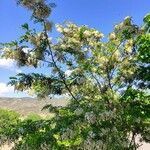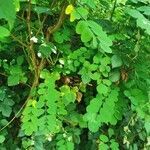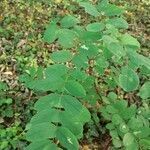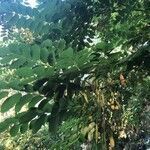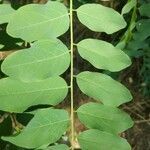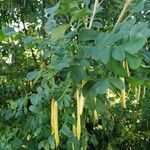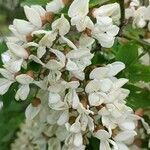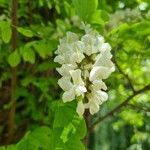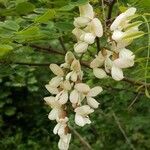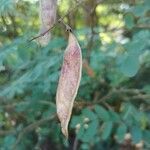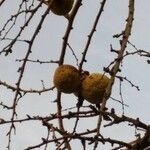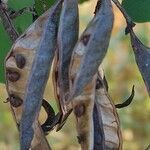An upright tree. It grows 22-25 m tall and spreads 12-15 m wide. The trunk can be 60 cm across. It loses its leaves during the year. The branches are slightly arching and thorny. The leaves are alternate and compound. The leaves are dark green with up to 19 small oval leaflets. The leaflets are 30-50 mm long. The central stalk is 20-30 cm long. There are 2 spines at the base of each leaf. The leaves turn yellow in autumn. The flowers are creamy white and have a scent. They are pea like. They occur in drooping clusters about 14 cm long. These are in the axils of leaves near the tips of branches. The fruit are pods 7-10 cm long and flat. These are thin walled, smooth and dark reddish-brown. There are several pods on a central stalk. The seeds are dark and bean like and 3-5 mm long. There are 4-8 per pod.
Tree to 25 m, the twigs and peduncles puberulent, becoming subglabrous; stipules commonly modified into spines 1 cm; lfls 7–19, oval or elliptic, 2–4 cm; racemes drooping, many-fld, 1–2 dm; fls white, fragrant, 1.5–2.5 cm; cal finely hairy, the upper lip truncate or broadly notched; ovary glabrous; fr 5–10 cm; 2n=20. Native from Pa. and s. Ind. to Okla., s. to Ga. and Ala., and often escaped from cult. n. to N.S. and Que. May, June.
Shrub or tree, up to 10 m high; robust, hard-wooded; bark thick, deeply furrowed, blackish. Leaves imparipinnate; stipules usually paired; spinescent. Flowers: intensely fragrant; in many-flowered racemes; corolla 15-20 mm long, white; Sep. Pods 50-100 mm long, with 4-10 seeds, not in distinct compartments.
Deciduous tree, 3-25 m. Leaves imparipinnate, leaflet pairs 4-6, stipules paired, spinose. Flowers in pendulous panicles, white, fragrant. Pods thin, straight, reddish brown, constricted between seeds, dehiscent; remaining on tree over winter.
